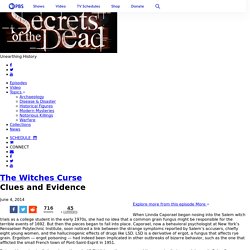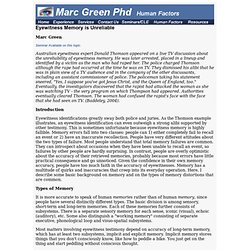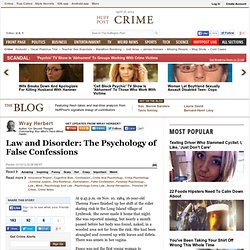

6 Surprising Facts About The Salem Witch Trials. The REAL HISTORY Behind the Salem Witch Trials. Forensic science and Witchcraft Trials. 7 Bizarre Witch Trial Tests. 1.

Swimming Test As part of the infamous “swimming test,” accused witches were dragged to the nearest body of water, stripped to their undergarments, bound and then tossed in to to see if they would sink or float. Since witches were believed to have spurned the sacrament of baptism, it was thought that the water would reject their body and prevent them from submerging. According to this logic, an innocent person would sink like a stone, but a witch would simply bob on the surface. The law and forensic science. History Channel: Salem Witch Trials. Unit 1: Salem Witch Trials. Clues and Evidence. When Linnda Caporael began nosing into the Salem witch trials as a college student in the early 1970s, she had no idea that a common grain fungus might be responsible for the terrible events of 1692.

But then the pieces began to fall into place. Caporael, now a behavioral psychologist at New York’s Rensselaer Polytechnic Institute, soon noticed a link between the strange symptoms reported by Salem’s accusers, chiefly eight young women, and the hallucinogenic effects of drugs like LSD. Salem Witch Trials of 1692: Facts, History & Causes. While the term 'witch-hunt' has become part of our common vocabulary, it has roots in the hysteria that befell Salem Village, Massachusetts, at the close of the seventeenth century.

Develop an understanding of the Salem witch trials and test your knowledge with a short quiz. A Puritan Background Puritans, or religious exiles from the Church of England who moved to the colonies with a hope of returning to England to 'purify' the Church, settled most of the Massachusetts colony. Puritan leaders had hoped their colony would serve as a 'city on a hill' for all those around the world to take note of. They believed it would be a righteous utopia where the citizens held a focus on God, showed deference to church leaders, and attended church. Visual Expert Human Factors: Eyewitness Memory Is Unreliable. Eyewitness Memory is Unreliable Marc Green Seminar Available on this topic.

Australian eyewitness expert Donald Thomson appeared on a live TV discussion about the unreliability of eyewitness memory. He was later arrested, placed in a lineup and identified by a victim as the man who had raped her. The police charged Thomson although the rape had occurred at the time he was on TV. Causes of Memory Unreliability 1. There are several reasons for this. The Right to Resist an Unlawful Arrest 78 Yale Law Journal 1968-1969. How to Detect Lies - body language, reactions, speech patterns. Interesting Info -> Lying Index -> How to Detect Lies Become a Human Lie Detector (Part 1) Warning: sometimes ignorance is bliss.

After gaining this knowledge, you may be hurt when it is obvious that someone is lying to you. The following deception detection techniques are used by police, forensic psychologists, security experts and other investigators. Introduction to Detecting Lies: This knowledge is also useful for managers, employers, and for anyone to use in everyday situations where telling the truth from a lie can help prevent you from being a victim of fraud/scams and other deceptions. This is just a basic run down of physical (body language) gestures and verbal cues that may indicate someone is being untruthful.
If you got here from somewhere else, be sure to check out our Lie Detection index page for more info including new research in the field of forensic psychology. Signs of Deception: Body Language of Lies: • A person who is lying to you will avoid making eye contact. People Can Be Convinced They Committed a Crime That Never Happened – Association for Psychological Science – APS. Evidence from some wrongful-conviction cases suggests that suspects can be questioned in ways that lead them to falsely believe in and confess to committing crimes they didn’t actually commit.

Research provides lab-based evidence for this phenomenon, showing that innocent adult participants can be convinced, over the course of a few hours, that they had perpetrated crimes as serious as assault with a weapon in their teenage years. The research, published in Psychological Science, a journal of the Association for Psychological Science, indicates that the participants came to internalize the stories they were told, providing rich and detailed descriptions of events that never actually took place.
“Our findings show that false memories of committing crime with police contact can be surprisingly easy to generate, and can have all the same kinds of complex details as real memories,” says psychological scientist and lead researcher Julia Shaw of the University of Bedfordshire in the UK. False Memories: How Our Memory Deceives Us (Discover Psychology) The Psychology of False Confessions - Wray Herbert. At 9:45 p.m. on Nov. 10, 1984, 16-year-old Theresa Fusco finished up her shift at the roller skating rink in the Long Island village of Lynbrook.

She never made it home that night. She was reported missing, but nearly a month passed before her body was found, naked, in a wooded area not far from the rink. She had been strangled and covered up with leaves and debris. There was semen in her vagina. Fusco was not the first young woman to disappear in the vicinity, and police were under tremendous public pressure to make an arrest.